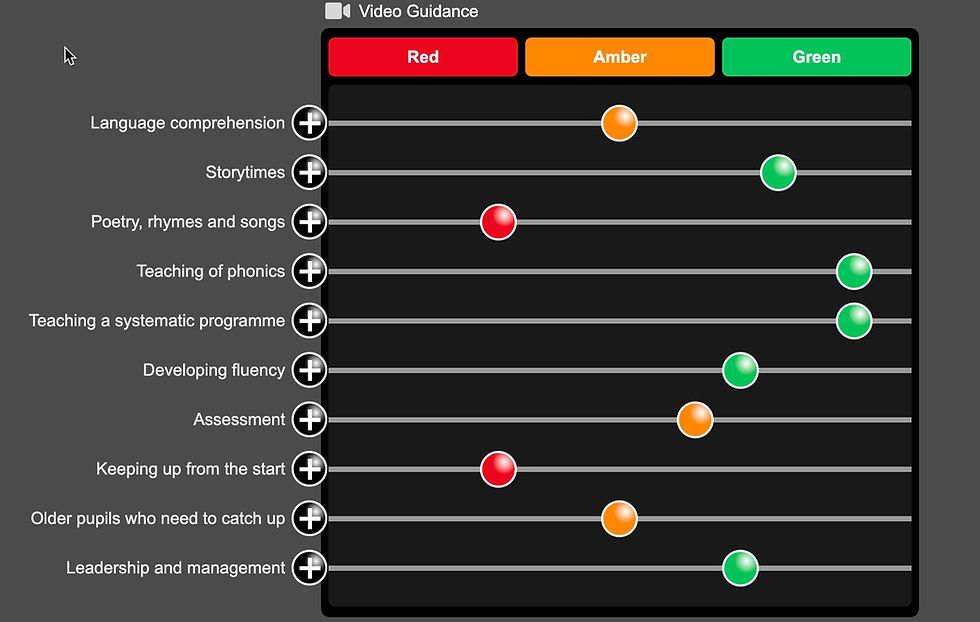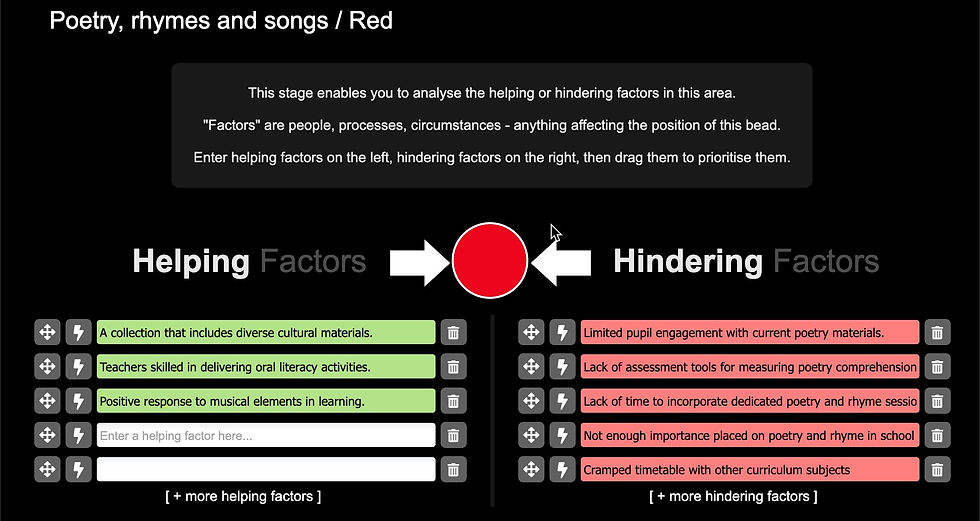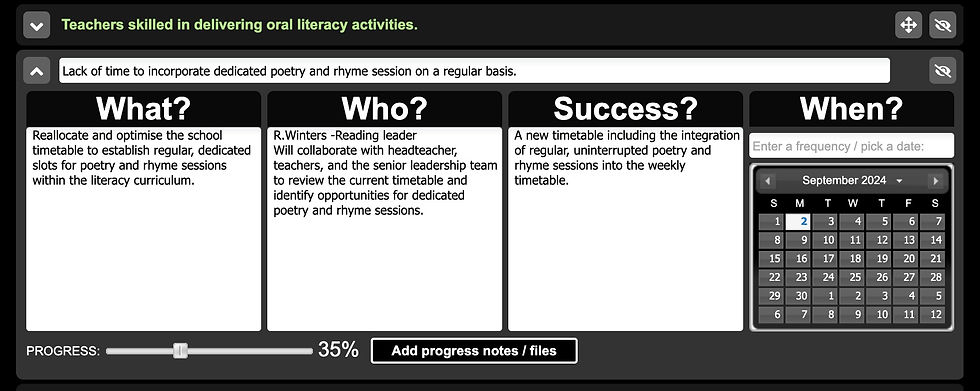Empowering Reading Leaders with iAbacus: Harnessing the DfE Reading Framework for Self-Evaluation and Strategic Planning

In today’s education landscape, reading is one of the top priorities and most talked about subjects, because it is a fundamental skill that underpins all aspects of education and is critical for students’ overall academic success. Therefore, the DfE created the Reading Framework to support schools in delivering high-quality reading instruction, to equip children with the skills they need for success now and on into the future. Self-evaluation and strategic planning are essential steps to guarantee that these skills are being nurtured. So as an educator how can you do this effectively? Enter iAbacus - an innovative online tool that simplifies the process of self-evaluation and improvement planning through a visual and interactive interface inspired by the classic abacus. This article will explain how iAbacus can be used to revolutionise your current reading provision.
The DfE Reading Framework
The DfE Reading Framework provides a structured approach to teaching reading, ensuring that schools implement consistent, evidence-based strategies that foster strong reading skills among students. It targets all children in school, from supporting early literacy development right through to developing a reading culture and language rich environment. It has recently been updated, as of July 2023, to include new guidelines on how reading should be taught. The updates include:
Decoding with fluency- Phonics lessons must still be taught to all children who have a reading age of less than 8 regardless of their school year.
EAL Guidance- The strategy of re-reading is to be implemented to expose them to familiar words and increase the number of words they can read at a glance.
Book bands- Levelling and banding books based on the phonetic content is no longer advised for children who can decode with fluency, to stop limiting children’s reading.
Book clubs and library time- A timetabled activity to encourage a reading discussion to promote an interest in and love of reading for each child.
Disadvantaged and SEND pupils- Additional resources and support strategies to help raise attainment in the lowest achieving pupils.
Wide range of texts- Schools need to provide a wide range of texts from chapter books, to joke books in order to foster a love of reading.
Framework Alignment
In alignment with the DfE guidelines, iAbacus offers a specialised Reading Framework template, it has been meticulously designed to help schools enhance their reading provision by addressing critical areas outlined in the framework, including developing fluency, keeping up and leadership & management. You can evaluate your school's performance using these criteria to ensure it meets the DfE's standards and incorporates all the latest updates in your reading provision and teaching.
This custom template in iAbacus supports reading leaders by streamlining self-evaluation, facilitating targeted action planning and ensuring Ofsted readiness through organised evidence collection. It also allows for monitoring, ongoing tracking of progress and adjustments to reading strategies. So less time can be spent behind a computer and more time helping the children to progress.
Using the iAbacus tool to evaluate reading is done in a few simple steps:
Make Judgements Based on Criteria: Evaluate the effectiveness of reading strategies and interventions across different areas, such as phonics, comprehension, and reading culture.
Provide Evidence: Collect and present data to support these judgements, showing the reasoning behind your judgement.
Analyse Helping and Hindering Factors: Identify factors that contribute to or detract from successful reading outcomes. This analysis enables you to make a personalised and specific action plan.
Strategic Action Planning: Once the self-evaluation is complete, iAbacus guides reading leaders through a structured action planning process involving developing an improvement plan, assigning responsibilities, setting timetables and choosing success markers.
Visual Nature
The visual nature of this tool makes it clear to see where your provision is right now and how far you need to go to give children the best education possible. The additional overlay feature allows you to see previous abacus and compare them with current one so you can clearly see how much you have improved and is a motivating way of helping school move forward in its journey to excellence.
The iAbacus Reading Framework Template
The iAbacus template can be used to create a well rounded picture of your reading provision across school. The main statements made in the DfE Reading Framework are listed down the left hand side of the abacus, after making a quick initial judgement, by sliding the bead, it becomes easy to see which areas need improvement.

Then after answering a few RAG rateable statements and writing down your evidence to support the position of the bead, you can fill in your helping and hindering factors. What is pushing your bead to the end of the abacus and what is holding your bead back?

Finally, you can write out a detailed action plan for each of these factors, not only to ensure the great provision you are already doing continues but also to improve any areas of weakness.

Once your abacus is complete, you can view it as a PDF document which can be given to show evidence to Ofsted, proprietors or governors. To see an example click below:
Time Saving and Efficient
Using iAbacus to evaluate and track your reading provision, is a time saving and efficient way to deeply analyse and track whole school progress. Because iAbacus encompasses analysis, evaluation and improvement planning it means all the documents and evidence you need are in one place so no more scrambling around to find what you need or losing folders full of information. It is quick and easy to use and by sharing your abacus with other staff members it allows for a collaborative approach to planning, meaning all members of your team know what they need to do to meet the next target.
Preparation for Ofsted
One of the significant advantages of using the DfE Reading Framework template is in preparation for Ofsted, as the template has been directly taken from the framework document. Using the same headings and criteria that Ofsted themselves are looking for means you have thoroughly analysed your reading provision against the same standards that they will measure against, so gone are the days of the mad dash to get all the books, planning and resources in a row because you can download your abacus into a PDF and everything you need to show Ofsted is there. You can demonstrate rigorous self evaluation and share with Ofsted your action plan, so not only are you showcasing your great provision and the progress you have made so far but also showing how you plan to improve outcomes for the children in your school.
The iAbacus DfE Reading Framework template offers an unparalleled tool for reading leaders committed to enhancing reading outcomes in their schools. Through the step by step process of self-evaluation, strategic action planning, and continuous improvement iAbacus not only prepares schools for Ofsted inspections but also nurtures a culture of excellence in reading education.
For reading leaders looking to make a real difference, iAbacus provides the clarity, structure, and support needed to achieve and sustain success. Explore the benefits of the DfE Reading Framework template in iAbacus today and take the first step towards transforming reading provision in your school.
Ready to Improve Reading Outcomes?
Sign up for a free trial of iAbacus at www.iabacus.com/trial or request a personalised online demonstration at www.iabacus.com/demo.
Empower your reading leaders with the tools they need for effective self-evaluation and strategic planning.
Comments